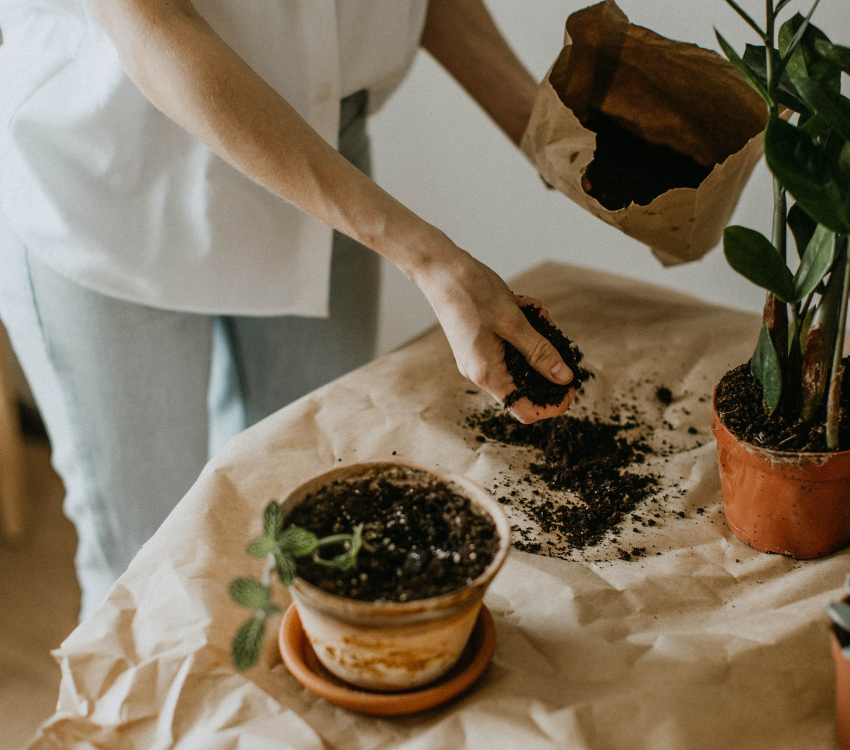“Tomatoes are technically fruits,” and still not consumed as a fruit. Instead, they become a perfect accompaniment to salads, wraps, and more. (Or a gastronomical necessity!) Plus, the point is that if all the weather conditions are favorable, Tomatoes can be grown in homes too. However, growing tomato plants can be tricky.
If your tomato leaves are turning yellow, your plant is not feeling well. (Li-te-ra-lly!) Some of the most common diseases found in a tomato plant are not only leaves turning yellow but also their leaves curling, damping off, bacterial wilt, bacterial leaf spot, and more.
And, if you are already a home gardener or soon starting to plant tomatoes at your home, you need to take note of some of the concerns you may face with growing a tomato plant.
Leaves turning yellow are not that big of a deal, but they need corrective measures to help them recover. So, let’s know all the reasons why tomato leaves turn yellow. However, I will not leave you in the middle, as my recommendations will not let your plant die.
Reasons why are your Tomato Leaves Turning Yellow?
Just like many others, you might only consider less watering as the only reason for the tomato leaves turning yellow. However, there are numerous other causes that are equally contributory to this disorder. Fortunately, all these can be rectified too.
1. Seed Leaves Turn Yellow
If you are a plantsman and newly entering to grow various plants, including tomatoes, don’t get worried if you spot two or three yellow leaves in the beginning. Cotyledon leaves the first few leaves after the first germination and grows only to provide the required nutrients for the growth of the plant.
As soon as the first leaves have done their job, they begin to turn yellow and eventually fall off. So, there is apparently no cause to worry about.
Remedy – Firstly, this particular thing doesn’t need to be fixed, nor is there any remedy available. Because it is a natural process for any plant to grow, you possibly can not do anything about it. The yellow leaves will fall off soon, and new healthy green leaves will grow.
2. Watering Complications

Watering any plant, including tomatoes, is very important. Only a correct amount of water will prolong the life of the plant. The most common mistake people make is that, in fear of the plant dying out, they over-water the plant leaving its roots to rot.
Less or almost no oxygen due to extreme hydration is one of the causes of the tomato leaves turning yellow. On the other hand, underwatering the plant will also dry out the roots, which will disrupt the easy flow of nutrients to all the parts of the plant.
The oxygen supply in the plant should get hampered, be careful neither to over nor to underwater. Therefore, be sure to have knowledge about the correct amount of hydration needed for a tomato plant to thrive.
Remedy – There is no unnecessary watering of the plant every day. Before watering your tomato plant, make sure to check that 1 to 2 inches of soil is dry. Also, alter your watering habits if your practice is causing water logging or drying out.
If you wish for your plant to grow healthy, water it in the morning. This will not let the water evaporate or cause the yellowing of the leaves. Also, make a point to always water the soil rather than leaves or roots. If your soil is wet and nutrient-rich, the leaves and roots of the plant will remain healthy for a long period of time.
In the case of underwatering, you have been trying to save the plant. Maybe it’s the root of the plant and not you. Although there is no saving the plant at this stage, try cutting the damaged or rotten roots. (I hope your tomato plant is rescued!)
3. Inadequate Aeration
Do you irrigate your tomato plant correctly? Have you planted it in the sunlight? Still, its leaves are turning yellow; maybe the problem lies with the soil. If the soil around the plant is not aerated or fluffy, it means there is a suffocating supply of oxygen needed for the plant to survive. (So yellow leaves!)
Since roots are struggling to get oxygen, they won’t be able to transport the much-needed essential nutrients, and water can’t be circulated to the entire plant. Needless to say, what happens next is the deficiency of enough food for the tomato plant leading to various diseases like its leaves turning yellow.
Remedy – Examine how many roots are established before self-aerating the soil bed. You can superficially plow the earth with your hands. However, this sort of soil aeration can damage the roots and directly affect your tomato plant.
Also, if you truly want to avoid soil compaction altogether, choose the soil bed carefully, as one of the main reasons for it is walking over the earth.
4. Transplant Disturbance
When seedlings are shifted from one pot to another, it’s normal for you to notice your tomato leaf turning yellow. What happens is that it takes time for the plant to settle down and adjust to new conditions.
Having said that, if you take good care of it, the shock will definitely reverse. However, even after several weeks, your tomato plant still has yellow leaves, which means that the plant is not fine-tuned with the new place.
Remedy – Transportation shock is a common condition that can easily be handled. If you want to avoid it totally, make sure that the temperature of the soil doesn’t go too low. Also, if you find that the shock is persistent, simply remove the yellow leaves, which will redirect the nutrients toward the growth of the plant and not in repair.
5. Nutrient Scantiness

In any plant’s overall health, Nitrogen is essential. If all the above pointers are taken care of, maybe your tomato plant is not getting the food it needs for survival and growth. And what happens is that the older leaves slowly turn yellow.
In the condition of chlorosis, tomato leaves turn yellow, and the primary cause of this is mainly the lack of micronutrients essential to the process of photosynthesis. By any chance, if the plant is unable to produce enough chlorophyll due to a paucity of nutrients, it’s natural for the healthy leaves to turn yellow.
Remedy – Fertilizer is the fix for nutrient deficiency. If you want to enrich the soil for your tomato plant, manure or fertilizers give the instant boost. One of the best ways to examine your soil to find the targeted micronutrient is a soil test.
For example, if your soil is calcium deficient, eggshells will solve that problem. And, if your soil misses the magnesium quotient, add Epsom salt. And if you don’t know, tomatoes are heavy feeders, so they always require a lot of nutrients for growth and repair. Therefore, frequent fertilizing will never let your tomato leaves turn yellow.
6. Diseases
Unfortunately, one of the biggest and the most worrisome causes for the tomato leaves to turn yellow is the plant getting affected by several fungal or bacterial diseases. Speaking of various conditions that need immediate attention are mostly four; therefore, let’s read more about them.
The first on the list is Blight. It crops up from a fungus in the soil, which is called Alternaria Solani. If you find the lower leaves turning yellow with brown patches, your soil is contaminated with Blight, and you will have to replace the entire soil bed with a healthy one.
However, it’s easy to identify this fungal disease in the tomato plant, which means if you detect this problem at an early stage, you might save your tomato plant.
Wilts
Wilts are very common but leave a trail of worries among the ones who have been growing and caring for their plant for a long time. Speaking of its various types, which are Fusarium wilt, Verticillium wilt, and Bacterial wilt. Not only do they ruin the entire plant, but it needs quick redressal.
Fusarium Wilt attacks the roots of the tomato plant and stops them from functioning correctly. There will be no water transportation to the entire plant, and it will turn the leaves yellow and wilted.
Verticillium Wilt is very similar to the Septoria leaf spot and has the condition of early blight. In this type of disease, the lower part of the leaf develops brown veins, and the rest of the leaf turns yellow. (Eventually falling off the plant!)
Although Bacterial wilt is one of the causes of wilted and yellow leaves, it is not found to be that common. Primarily, one can find this particular problem in tomato plants grown in sandy soil.
Remedy – If I speak about its fix, whenever you notice something not normal with the plant, check for the signs and identify the problem. After the diagnosis, immediately treat the condition. If it is repeatedly happening with your plants, change the soil only.
Also, to your disappointment, there is no solution available if your plant is infected by fungi. The only solution is to remove the plant so that it doesn’t infect others. Also, if it’s early blight, simply remove the infected part.
Some of the ways you can totally avoid the diseases that affect the health of your plant are maintaining the PH balance (around 6.5), mulching around the plant, pruning the plant’s leaves, preventing soil splashback, etc. Also, clean your gardening tools regularly to limit the spread of disease from one plant to another.
7. Pests

Speaking of tomato leaves turning yellow and not talking about the pest attack is a mistake. Pests are a mess-creator in your garden, which attack everyone. Because tomato plants attract a lot of pests, not only leaves but the overall plant will be affected.
Some of the pests that attack the plant are hornworms, cutworms, spider mites, flea beetles, and whiteflies. Also, their source of feeding is the sap from the plant, which weakens the plant. (Yellowing of the leaves is just one of them.)
Remedy – If you want to avoid the infestation altogether, the natural way is to host ladybugs, lacewings, parasitic wasps, and spiders (predatory insects) that will protect your tomato plant by attacking the pests first.
Another way is to trick the pests by planting colorful or flowering plants that will distract them from attacking your precious tomato plant. Furthermore, the manual way to remove pests is also quite effective.
8. Natural & Inevitable Yellowing
Well! All the above-mentioned reasons are due to something or some condition. However, there is something at the end of the season, yellowing, which is very normal. If it’s the end months of the year, you will notice tomato leaves turning yellow; however, the good news is that they will fall off, and the new leaves will sprout on their own. And also, if you don’t know, leaves fall off only to redirect the essential nutrients when the plant is fruiting. Therefore, don’t get worried.
Remedy – If you want to know about the fix of end-of-season yellowing of the leaves, interestingly, there is none. Why? Because it’s the tomato plant’s life cycle, which needs no redressal. However, all you can do is prune the dead leaves immediately.
The Bottom Line
As a plant-lover myself, I understand how distressing it gets when your plant doesn’t thrive. However, if your tomato leaves are turning yellow, instead of getting panicky, treat the plant immediately according to the problem and save it.
Also, keep a regular eye on the plant so that you can detect the problem at an early stage and eliminate it. If you found this blog insightful, leave a comment below.
Happy Gardening!







